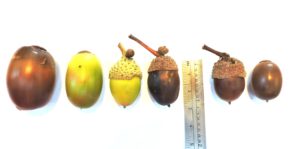
The list below ranks in order the top 40 favorite wildlife preferred nuts.
The ranking is determined using two criteria to describe the role of the plant food in animals’ diets:
1) the number of species that utilizes the food,
2) how significant the food is within an individual species overall diet
So while a food may not be popular across a large number of species, it still could be strongly preferred by a few species. By coordinating with a rehabber’s specific needs, a forager can decide which plants to best target for collection.
Be sure to check any item listed below in the database to see if there are any toxicological warnings associated with that plant or part of the plant.
| Common Name | Botanical Name | |
| 1 | oak, generally | Quercus spp. |
| 2 | beech, American | Fagus grandifolia |
| 3 | oak, northern red | Quercus rubra |
| 4 | oak, chinkapin | Quercus muehlenbergii |
| 5 | hickory, generally | Carya spp. |
| 6 | hickory, pignut | Carya glabra |
| 7 | walnut, generally | Juglans spp. |
| 8 | hickory, shagbark | Carya ovata |
| 9 | walnut, black | Juglans nigra |
| 10 | hazelnut | Corylus spp. |
| 11 | oak, white | Quercus alba |
| 12 | hickory, mockernut | Carya alba |
| 13 | oak, southern red | Quercus falcata |
| 14 | butternut | Juglans cinerea |
| 15 | hophornbeam, eastern | Ostrya virginiana |
| 16 | oak, bear | Quercus ilicifolia |
| 17 | oak, black | Quercus velutina |
| 18 | oak, willow | Quecus phellos |
| 19 | chestnut, generally | Castanea spp. |
| 20 | hickory, shagbark | Carya ovata |
| 21 | chinquapin, Allegheny | Castanea pumila |
| 22 | oak, chestnut | Quercus prinus |
| 23 | oak, pin | Quercus palustris |
| 24 | oak, southern live | Quercus virginiana |
| 25 | peanut | Arachis hypogaea |
| 26 | oak, swamp chestnut | Quercus michauxii |
| 27 | oak, scarlet | Quercus coccinea |
| 28 | oak, black | Quercus nigra |
| 29 | oak, swamp white | Quercus bicolor |
| 30 | oak, turkey | Quercus laevis |
| 31 | oak, Shumard’s | Quercus shumardii |
| 32 | pecan | Carya illinoinensis |
| 33 | oak, overcup | Quercus lyrata |
| 34 | hickory, mockernut | Carya tomentosa |
| 35 | oak, bluejack | Quercus incana |
| 36 | oak,post | Quercus stellata |
| 37 | oak, pin | Quercus palustris |
| 38 | chestnut, American | Castanea dentata |
| 39 | hazelnut, American | Corylus americana |
| 40 | hazelnut, beaked | Corylus cornuta |
What Criteria is Used for the Ranking the Lists?
The main resources used to build this website usually rated foods in three levels of preference: high, middle and low. But, a plant may be high preference in Michigan but lower preference in Virginia. So the preference factor has some built in limitations. Still, it is factor #1 in the algorithm.
The second factor considered was how many species of animals ate the part of the plant in consideration. A seed that 29 species of animals eats would outrank a seed that only 5 species eats.
From a foragers perspective, it would be ideal to collect the most highly preferable foods that feed the widest range of rehabilitation animals, right? Well maybe not.
Consider if a rehabilitator only works with foxes. To research which foods would be most beneficial in the “fox only” scenario, the only consideration that she would care about is the most preferred food for foxes, not how many other species ate it.
So the ranking lists are the most general broad interpretation of the data. You will want to generate your own lists from the search feature to find out just what you want to target for collection.
References Used with Permission
The Fire Effects Information System, U.S. Department of Agriculture, Forest Service, Rocky Mountain Research Station, Fire Sciences Laboratory (Producer).
Fire Effects Information System (2017) Plant species ecology literature reviews. Retrieved various dates from https://www.feis-crs.org/feis/
Martin, A.C., Zim, H.S., Nelson, A.L. (1951). American Wildlife and Plants: A Guide to Wildlife Food Habits. New York: Dover Publications.
Scott, M. (2013). Songbird Diet Index. National Wildlife Rehabilitators Association, St. Cloud, MN.
